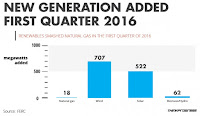In the first three months of 2016, the U.S. grid added 18 megawatts of new natural gas generating capacity. It added a whopping 1,291 megawatts (MW) of new renewables.
The renewables were primarily wind (707 MW) and solar (522 MW). We also added some biomass (33 MW) and hydropower (29 MW). The Federal Energy Regulatory Commission’s (FERC) latest monthly Energy Infrastructure Update reports that no new capacity of coal, oil, or nuclear power were added in the first quarter of the year.
So the U.S. electric grid added more than 70 times as much renewable energy capacity as natural gas capacity from January to March.
Of course, generating capacity is often quite different from the amount of power generated, since fossil fuel plants generally are used for considerably higher percentage of the time (their “capacity factor”). That’s why renewables now make up 18 percent of total U.S. installed generating capacity — but only about 14 percent of our total power production.
On the other hand, FERC doesn’t track rooftop solar, so its estimate of solar capacity added is certainly low. Indeed, FERC’s data sources only “include plants with nameplate capacity of 1 MW or greater,” so it’s hard to know how much small-scale renewable power generation they may have missed.
It is increasingly clear that we don’t need to add significant amounts of any new grid capacity that isn’t renewable for the foreseeable future. In part that’s because demand for utility power generation has been flat for almost a decade — and should continue plateauing for quite some time — thanks to rapidly growing energy efficiency measures (and, to a much lesser extent, thanks to recent increases in rooftop solar).
We also know that renewable power — both new wind and solar — is now winning bids for new generation around the world without subsidies. Some bids are coming in at under four cents per kilowatt hour!
Studies from NOAA and others — and real-world examples around the globe, such as Germany — show that the U.S. can absorb vastly greater percentages of renewables than we currently have, just with existing technology. Yet NOAA’s research shows that, with nothing more than an improved national transmission system, “a transition to a reliable, low-carbon, electrical generation and transmission system can be accomplished with commercially available technology and within 15 years.”
A 2015 study showed that we could “decarbonize the electricity supply with a proportionally small requirement for BES [Bulk multi-hour Electricity Storage] because gas provides much of the intermittency management even when the carbon emissions intensity is cut to less than 30% of today’s U.S. average.”
Thus, we really have more than enough natural gas plants in most places to take us to the point where electric vehicles, second-life EV batteries, advanced solar thermal power and other affordable bulk storage would be needed to finish the decarbonization of the grid post-2030.
Read more at Renewables Are Leaving Natural Gas in the Dust This Year


No comments:
Post a Comment